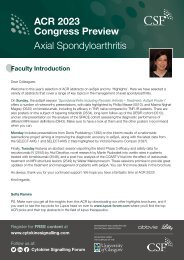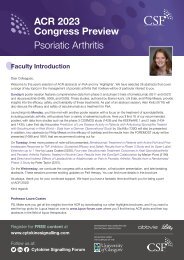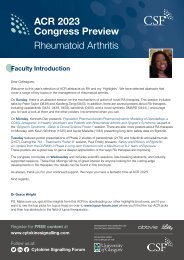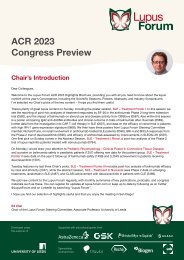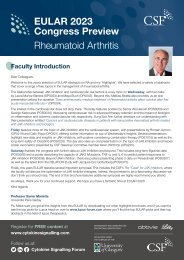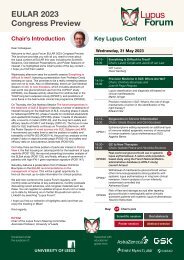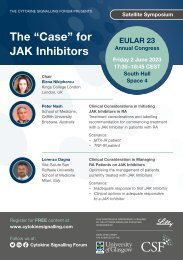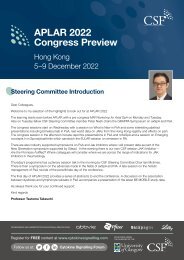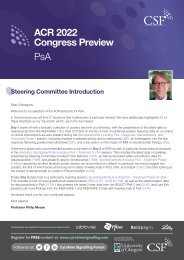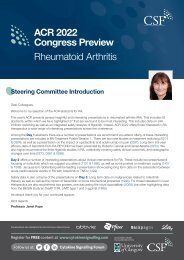ACR Congress Review 2019
You also want an ePaper? Increase the reach of your titles
YUMPU automatically turns print PDFs into web optimized ePapers that Google loves.
Upadacitinib in axial spondylarthritis<br />
Ismail and colleagues presented a sub-analysis of the SELECT-AXIS I study to explore the relationship<br />
between upadacitinib exposures and several ankylosing spondylitis (AS) efficacy endpoints and safety<br />
parameters to support dose selection for future studies. Upadacitinib plasma exposures in patients with<br />
AS were also compared with those in RA. A total of 187 patients were included (upadacitinib 15 mg QD,<br />
n=93; placebo, n=94). Patients in the active treatment arm had statistically significant higher response<br />
rates for ASAS 40, ASAS 20, and ASAS PR compared to those in the placebo arm. However, within the<br />
single active treatment arm there were no clear exposure-response relationships between increasing<br />
upadacitinib average concentrations and the probability of achieving the evaluated efficacy outcomes,<br />
suggesting the achievement of a plateau in response. With increasing upadacitinib exposure, there was<br />
an increase in the percentage of subjects experiencing decreases of haemoglobin of ≥ 1 g/dL from<br />
baseline, and no upadacitinib exposure-dependent increases in percentage of subjects experiencing<br />
lymphopenia or infection were observed. Upadacitinib plasma concentrations and pharmacokinetic<br />
parameters (drug clearance and volume of distribution) in patients with AS were similar to those<br />
previously observed in subjects with RA in the SELECT-BEYOND and SELECT-NEXT studies. Overall,<br />
the results of this analysis support selection of the upadacitinib 15 mg QD dose for further evaluation in<br />
future AS/axial SpA studies [1492].<br />
BTK inhibitors<br />
Fenebrutinib in RA – Phase 2 results<br />
Cohen and colleagues presented findings from a fenebrutinib Phase 2 study, which enrolled patients<br />
with moderate-to-severe active RA with an inadequate response to either MTX (Cohort 1) or TNF<br />
inhibitors (Cohort 2). Results were presented for cohort 2 TNF-IR patients, who were randomised to<br />
fenebrutinib 200 mg (n=48) or placebo (n=50); the majority of patients (98% and 90%, respectively)<br />
completed the 12-week study. <strong>ACR</strong>20/50/70 responses in were greater for fenebrutinib versus placebo<br />
(58/25/15% versus 24/12/4%) and generally increased over time, with a plateau of <strong>ACR</strong>50 after Week 8<br />
for all patients. At Week 12, DAS28-CRP decreased by -1.43 and -2.26 from baseline in the placebo and<br />
fenebrutinib arms, respectively. More patients in the placebo arm (45%) than in the fenebrutinib arm<br />
(22%) reported at least one AE, and no serious AEs were reported. One case of herpes zoster and two<br />
grade 3 chemistry abnormalities (low phosphorous, high uric acid) were reported in the fenebrutinib arm.<br />
There were no clinically significant changes in haematology or immunoglobulin parameters. No Grade 4<br />
or 5 abnormalities were reported. No deaths or malignancies were reported. In summary, fenebrutinib<br />
demonstrated higher efficacy rates across disease activity measures versus placebo at Week 12 in the<br />
TNF-IR population and the safety profile was acceptable [929*].<br />
New agents<br />
PF-06650833 in RA: Phase 2b results<br />
Danto and colleagues presented Phase 2b study results for PF-06650833, a highly selective, small<br />
molecule, reversible IRAK4 inhibitor in development for RA treatment. Patients with moderately to<br />
severely active ACPA-positive RA and an inadequate response to methotrexate were randomised to<br />
12 weeks’ dosing with PF-06650833 20 mg, 60 mg, 200 mg, 400 mg modified-release tablets QD,<br />
tofacitinib 5 mg BID, or placebo. Overall, 269 patients were randomised and treated (PF-06650833,<br />
n=187; tofacitinib, n=43; placebo, n=39). Mean change from baseline in Week 12 SDAI was significantly<br />
higher in the PF-06650833 arms versus placebo (P≤0.005) and in the 200 mg and 400 mg groups<br />
(sensitivity analysis; P



